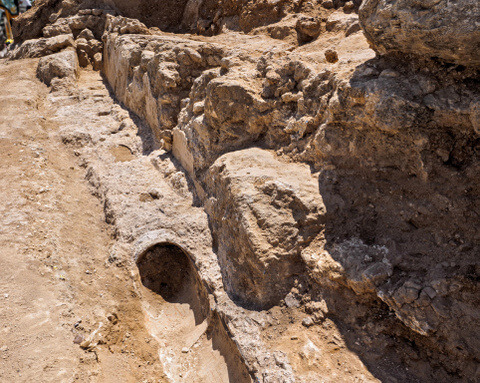The Amma route was built in open areas in the past, but with the expansion of Jerusalem in the modern era, it passes through the boundaries of several neighborhoods: Umm Tuba, Zur Behar, Mizrah Talpiot and Abu Tor. Since it is one of the main sources of water for Jerusalem, the rulers of the city for generations made sure to renovate and preserve it for about two thousand years, until it was replaced nearly a century ago, with a modern system that works on electricity.

A section of Jerusalem's lower aqueduct that brought water to the city more than 2,000 years ago, was recently uncovered in the Umm Tuba neighborhood (near the Har Huma neighborhood). The aqueduct was discovered during work to lay a sewer line in the neighborhood by the Gihon company, as part of a large-scale project led by the Gihon CEO, Zohar Yanon, to install a modern sewer network for the well-being of the residents of Umm Tuba and Tzur Bahar.
Following the discovery of the forearm, the Antiquities Authority opened an archaeological dig at the site. According to Jacob Bilig, the director of the excavation, "The lower aqueduct to Jerusalem, which was established more than two thousand years ago by the Hasmonean kings in order to supply water to Jerusalem, operated intermittently until about 100 years ago. The beginning of the tributary is in Ein Itam, near Shlomo Pools south of Bethlehem, and it is about 21 km long. For most of its length, it flows with a very small gradient, with the water dropping one meter every kilometer. First, the water flowed in an open canal, and about 500 years ago, during the Ottoman period, a clay pipe was placed inside it, so that the water would be more protected.
The Amma route was built in open areas in the past, but with the expansion of Jerusalem in the modern era, it passes through the boundaries of several neighborhoods: Umm Tuba, Zur Behar, Mizrah Talpiot and Abu Tor. Since it is one of the main sources of water for Jerusalem, the rulers of the city for generations made sure to renovate and preserve it for about two thousand years, until it was replaced nearly a century ago, with a modern system that works on electricity.
Due to its historical and archaeological importance, the Antiquities Authority takes care to prevent damage to it, and works to uncover parts of its remains, research them and make them accessible to the general public.
The forearm section has been documented, studied, and covered for the benefit of future generations. Other sections of the Long Arm have been preserved for the benefit of the general public and can be seen in the tunnel of the Governor's Palace, on the Shrubber Promenade, and around the Sultan's Pool, and other projects related to the aqueduct are planned.
The Antiquities Authority noted favorably the professional and thorough attitude of the Gihon in all that is related to the excavation efforts and the discovery of the antiquities.

One response
This is King Balestin I's private pipe